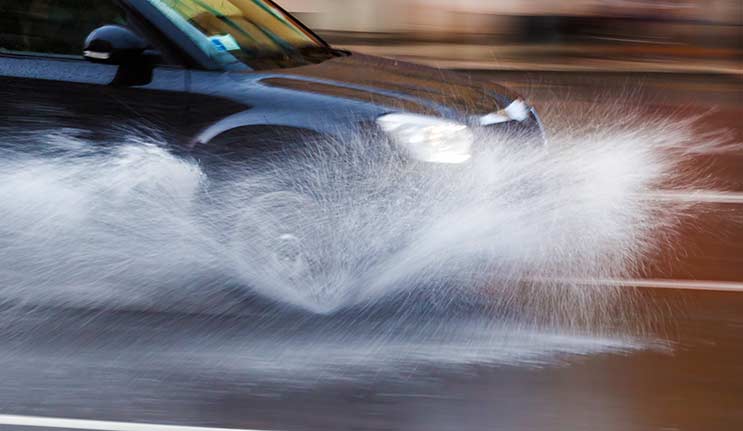Extreme weather has increasingly been making headlines lately. With winter approaching, much of the country will be facing hazardous road conditions on a regular basis. A recent study of the deadliest roads in Florida completed with SteinLaw Miami found that high traffic, varying speed limits on the same road and lack of pedestrian safety could be attributed to most accidents. Unfortunately, many of the dangers on the road are out of our control, but you can still follow some pointers to stay safe this winter.
Driving in Rain
Windshield wipers should be replaced every 6-12 months. Set yourself reminders to check and replace your wipers every September and March. This way you will be ready for the rain and snow seasons.
When driving in the rain make sure you have your headlights on even during the day. It will help other cars see you better and help your visibility.
You should also never drive into a flooded roadway. If you are unable to see how deep the water is it is unsafe to attempt driving through. You should also decrease speed to prevent hydroplaning. If you do hydroplane be sure to not slam your foot on the breaks as it will make it harder to gain control of the car again. You should take your foot off the break and continue to steer in the direction you want the car to go.
Driving in Fog
Most people will instinctively turn on their high beams when they encounter fog. Fog will reflect the light and make it even harder for you to see. Using your low beam headlights will help you be able to see enough to slowly navigate through the fog or to a safe spot to stop. Never drive in thick fog that you cannot safely see through. Pull over and wait it out to avoid hitting cars that might veer out of their lanes, pedestrians or animals that you will not have proper time to avoid.
Driving in Snow & Ice
The most important thing to remember is to slow down when you are driving in snow. As winter progresses it is easy to get comfortable while driving in the snow and not decrease your speed accordingly. Your tires will have a difficult time finding solid contact with the road’s surface to safely stop in a patch of snow, so you should be sure to have good snow tires or chains as required. You will also want to increase the distance that you drive behind anyone to avoid a collision if you are unable to stop your car as quickly as usual.
Remember that bridges and overpasses will freeze first during a snow storm, so use caution and slow down prior to crossing. If you do start to skid do not slam on the breaks. You will want to lightly pump the breaks as needed to decelerate without skidding out of control.
You will also want to give yourself proper time to clear off your car before starting your trip. Driving with snow on top of your car or covering your lights is not only dangerous, but often illegal. The snow drifts from the top of cars can create a dangerous situation for cars behind you and not making your lights visible can put you in danger when other cars have a difficult time spotting you. Have a spare snow scraper and shovel in your car so you can get yourself out of any snowy situation you encounter while you are out.
Encountering Wild Animals While Driving
Animals do not understand that rules of the road. It is impossible for them to differentiate from the road and the field or forest that they may live in nearby. If you encounter an animal-crossing sign you should take it seriously and slow down and scan for animals or reflective eyes on the side of the road.
For most animals, you will want to avoid swerving if you cannot stop in time before hitting the animal. Most experts will agree that you are in more danger of swerving into oncoming traffic or a tree/sign than if you hit the animal. However, when it comes to moose you will always want to avoid hitting them as much as possible. Moose are extremely large animals. Running into one will often result in significant vehicle damage and severe personal injury.
Preparing Your Car for Emergency Situations
Regardless of what type of weather you experience during the winter months you should make sure that you are prepared. In all situations, you will benefit from staying up to date on oil changes, filling all fluids including windshield wiper fluid and checking your tire treads regularly. Do not put off these updates because they could help save your life if you ever find yourself in a dangerous driving situation.
Every car should have an emergency road kit that is updated yearly. Important items to have in every kit are:
- Water boxes or water purification tablets
- Protein bars
- Emergency blanket
- Flashlight
- Road flares
- Matches
- Rain poncho
- Extra clothes / shoes / hat / gloves / socks
- First aid kit including gauze, tape, aspirin and antiseptic
- Tool kit including jumper cables
- Spare tire and the necessary tools to change your tire
You can add many other items to your emergency kit but these are the bare minimum that should be included in every car.
Following these tips and giving yourself some time to maintain your vehicle and supplies will ensure that you and your loved ones are as safe as possible while driving.
About the Author
 Ericka Murray grew up in Albany, New York where she earned degrees in Communications and Art History while attending the University at Albany. She loves to travel and recently settled down in San Diego, California to work as a public relations specialist.
Ericka Murray grew up in Albany, New York where she earned degrees in Communications and Art History while attending the University at Albany. She loves to travel and recently settled down in San Diego, California to work as a public relations specialist.
Protect your employees with these training courses on driver safety:
Extreme Driving Conditions – Small Vehicles
Extreme Driving Conditions – Large Vehicles
Defensive Driving – Small Vehicles
Defensive Driving – Large Vehicles
Speeding Awareness – Small Vehicles



